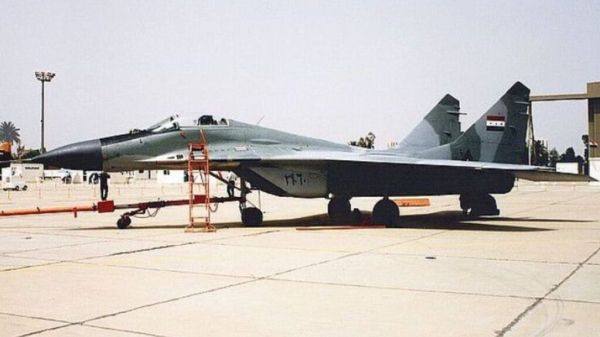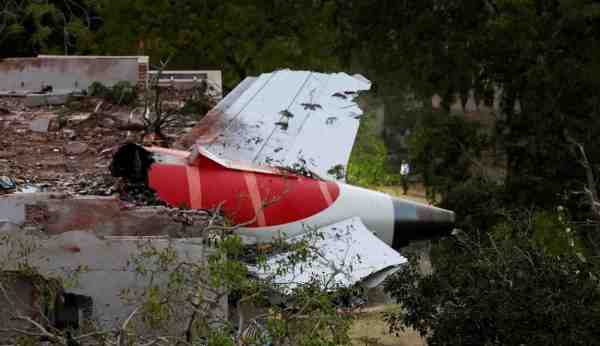The First Gulf War, which is often called the Persian Gulf War or referred to by its military name of Operation Desert Storm, began on January 17, 1991, in response to Iraq’s invasion of Kuwait. A coalition led by the United States fought to expel an Iraqi army of some 300,000 troops from Kuwait. Yet Iraq’s ground forces were far from the only hazard faced by coalition forces. Iraq fielded one of the largest air forces in the world, forcing coalition generals to plan for the threat that Iraq posed from the air.
By some scholarly accountsSaddam Hussein’s Iraq fielded the world’s sixth-largest air force, consisting of 700 or more aircraft. Many of them were parked in armored hangars or even stored underground. Nevertheless, the coalition had an unexpected level of success in destroying Iraq’s planes on the ground using 2,000-pound bombs. Aerial engagements were relatively rare, with only 22 Iraqi jets shot down in combat. In a desperate attempt to save as many planes as possible, Iraq directed its pilots to fly dozens of aircraft to its former adversary, Iran, which did not return the planes after the war.
Despite the massive size of its air force, Iraq ultimately proved not to be a formidable airborne adversary. This can be attributed in part to the age of Iraq’s fleet, with many of its aircraft dating to the 1960s and 1970s. Few of them were fourth-generation fighters like the F-15 Eagle, one of the U.S. Air Force’s most dangerous military aircraft, and possibly as few as 55 out of Iraq’s 700 jets could fire modern air-to-air missiles worthy of tangling with modern military aircraft. Still, some of Iraq’s many planes posed a potentially serious threat to coalition aircraft and ground forces.
Mig-29 Fulcrrum
The MiG-29, originally built by the Soviet Union and now by Russia, is widely exported and is one of the most commonly used fighter jets around the world. NATO assigns foreign aircraft code names to make it easier to identify and discuss them, and the MiG-29’s designation is Fulcrum. The MiG-29 was one of the most powerful aircraft in Iraq’s air force, but it was also one of the newest, and Iraq had only had about 30 of them by 1991.
The MiG-29 can reach speeds of Mach 2.25, or more than twice the speed of sound, and is also very agile. It was developed to counter American-built jets such as the F-15 Eagle and the F-16 Fighting Falcon. Its delta wings and aerodynamic fuselage give the Fulcrum its aerobatic agility, as the Soviet air command wanted a dogfighter. It also boasts advanced avionics, radar, and missiles, and its status as a multi-role fighter means it can also attack ground targets.
The United States acquired 17 MiG-29s from the former Soviet republic of Moldova after the breakup of the Soviet Union in the 1990s, giving U.S. engineers an up-close look at the jet. Western air forces, by that time, had also gotten a good look and some flying time in former East German MiG-29s. The consensus is that the Fulcrum is a very fast and maneuverable jet that is more than capable of humbling some of its rivals, even the highly agile F-16. It can lock its Archer missiles onto targets even when the Fulcrum’s nose isn’t pointed anywhere near the direction of its enemy, both sobering lessons for NATO air forces. At the same time, the Fulcrum lags in communicating battlespace information to its pilot, a strength of many Western jets.
MIG-25 Foxbat
The MiG-25 Foxbat was a high-speed interceptor that could fly at an almost berserk speed of Mach 2.83, or nearly three times the speed of sound because it was originally designed in the 1950s to intercept American spy planes like the U-2 and the SR-71. In fact, the Foxbat was second only to the SR-71 Blackbird as the fastest jet ever built. This speed made the MiG-29 Foxbat jet terrifying to Western air forces when it first debuted. Iraq’s air force fielded 32 MiG-25s, with 25 of those equipped for an air-to-air role. Iraq’s Foxbat pilots were considered the Air Force’s elite.
The Foxbat was designed to fly at extremely high altitudes and high speeds, subjecting it to intense heat stress. To mitigate this, engineers constructed it with a stainless steel body. A pair of afterburning turbojet engines gave it enough power to overcome the weight of its steel design at the expense of fuel efficiency and flying range. The Foxbat was equipped with long-range radar and carried air-to-air missiles. When used in a reconnaissance role, the missiles were often left behind in favor of additional cameras and surveillance equipment. In theory, the MiG-25 could penetrate deep into enemy territory on reconnaissance runs.
In reality, the Foxbat’s enormous appetite for fuel limited its range, and its weight meant that in lower-speed combat situations, it wasn’t very maneuverable. Plus, in 1976, a Soviet pilot defected to Japan with his Foxbat, which the United States quickly acquired. With a close-up look at the aircraft, Western analysts soon realized that its very impressive specs masked some severe limitations. Nevertheless, the initial alarm at the jet’s capabilities led the U.S. to develop its own air superiority fighter, the F-15 Eagle, which still flies with the U.S. Air Force today.
Su-24 Fencer
The Su-24 Fencer was one of Iraq’s premier strike aircraft, although it made up a relatively small percentage of the total fleet. One source describes Iraq as having a single squadron of 16 Fencers, but documents released after the war show that 24 Su-24s managed to escape to Iran. Whatever the number of Fencers that made the flight to Iran, it indicates how valuable the Iraqi Air orce considered the jet since it was willing to send most or all of its Fencers to an enemy country in hopes of preserving them. Since Iran didn’t return them, the scheme failed.
The Fencer was designed as an all-weather, low-level attack aircraft for ground strikes against hardened targets. It was developed as the Soviet response to the American F-111, and the two aircraft bear many similarities, although the Su-24 was smaller. The Fencer has swept-back, variable swing wings that can be configured for different flight conditions ranging from high speed to maneuverability. The Su-24 can be considered a bomber, and it’s a nuclear-capable one at that, although Iraq’s military did not possess any nuclear weapons. The Su-24’s two-person crew sits in a side-by-side cockpit configuration.
The Fencer was designed to penetrate enemy air defenses in all weather conditions during both day and night. The Su-24M variant has a top speed of about 960 mph and a range of 1,800 miles, aided by up to three external fuel tanks. Its flight ceiling is relatively low at 36,000 feet, but its climb rate exceeds 29,500 feet per minute. Versions made after 1986 feature forward-looking and terrain-following radars, along with advanced avionics and the capability to drop precision-guided munitions. The Fencer has also served in the air forces of several former Soviet republics.
MIG-23 Flogger
The MiG-23 Flogger was one of the workhorses of the Iraqi Air Force, although different sources offer different estimates of how many Floggers Iraq possessed. There were up to 120 combined MiG-23 and MiG-23BN aircraft in Iraq’s arsenal, per one pre-war source, or about 90 MiG-23 jets overall, according to other estimates. Either way, roughly one out of seven of Iraq’s military jets were Floggers. Only the older and lighter MiG-21 and its Chinese J-7 variant significantly outnumbered the MiG-23, with about 200 units combined. Plus, the Mirage F-1 was deployed in numbers similar to the MiG-23.
The MiG-23 was a variable swing-wing aircraft, the Soviet Union’s first jet of that type, preceding the Su-24 Fencer. The MiG-23 went into production in 1969, and 5,000 would ultimately be built, making it the most numerous swing-wing aircraft ever manufactured. As with the Fencer, being a swing-wing fighter jet gave the MiG-23 the ability to adjust its wing geometry for different flight conditions and speeds. Its configurable wings worked in conjunction with a turbojet engine, producing 27,500 pounds of thrust, which was sufficient for a top speed of up to Mach 2.4, making the MiG-23 a formidable and fearsome flyer for its time.
It was also well-armed, sporting a twin-barreled 23 mm cannon and hard points for six air-to-air missiles. The Flogger could fire short-range infrared homing missiles or medium-range Apex missiles. The Soviets had hoped the jet would prove to be a formidable dogfighter, but NATO analysts weren’t particularly impressed with it. Their low grade for the Flogger was borne out by its high rate of combat losses in the service of various air forces, including Iraq, which lost at least 50 MiG-23s to American-built Iranian air force planes during the Iran-Iraq war.
Mirage F1
Like the MiG-23, the Mirage F1 was one of the Iraqi air force’s most numerous relatively modern fighters, with estimates ranging between 60 and 95 of the French-built jets in Iraqi service. While the F1 is an older jet, it remains one of the highest-flying military fighter jets ever built, with a flight ceiling of 60,700 feet. This is impressive for a plane that made its debut in the mid-1960s, as is its top speed, just under Mach 2. Its manufacturer, Dassault Aviation, sought to build a small and inexpensive fighter for the export market.
Yet after France withdrew from NATO in 1966, the French Air Force shifted its priorities and realized the need for an interceptor that could also function as a penetrator. This led to the F1 becoming the successor to the Mirage III in the French Air Force, in addition to its export role. Unlike the delta-winged Mirage III, the F1 featured a swept-back wing design. This new configuration was a significant advance, as it gave the F1 40% more combat flying range while also optimizing lift during low speeds. The latter feature allowed it to land on runways only half as long as those required by the Mirage III.
The F1 carried twin 30 mm cannons and two medium-range air-to-air missiles. It could be equipped with anti-ship or laser-guided missiles, or it could carry up to eight rocket pods, each firing 18 rockets. The Mirage F1 served in the air forces of numerous countries, including Iraq, where it split the bulk of combat duties with the MiG-23.








